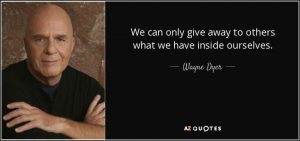For over 40 years East Berlin was controlled by the communists. West Berlin was free. One day some people who lived in East Berlin took a truck-load of garbage and dumped it on the West Berlin side. The people of West Berlin could have reacted by doing the same thing. But, instead they took a truckload of canned goods, bread, and milk and neatly stacked it on the East Berlin side. On top of this stack of food they placed the sign: ‘Each gives what he has.’
Life can get very busy, taxing, blissful, most happening, fast and grim. Occasionally, living can become a challenge as life seems to throw us in the corner or deep end. In times like that, what matters the most is, how we handle the situation. A word of hope form somebody, a voice that assures that it will get better makes the difference. Our thoughts and our actions can help in lessening darkness, and rise strength to carry on. We give what we have. Yes, when we are happy, we spread happiness and when we are low, we spread blues. But the fact is, we chose to be happy or sad, regardless of what surrounds us.
There are people like Dr. Prakash Baba Amte and his wife Dr. Mandakini Amte. The couple’s contribution to society is untold. I think, Dr. Amte and his wife are inspiration to the world and are the quintessence of self-actualization. After finishing his degree in medicines, Prakash’s father Baba Amte, took him on a picnic to Hemalkasa, which became a turning point in Prakash’s life. He felt terribly restless seeing that, while people had reached the moon, there were people living worse than life of animals. In Hemalkasa, the most basic things to live – food, clothing, medical help and shelter were not available. Dr.Prakash decided to become a part of Hemalkasa people.
Dr. Mandakini and Prakash loved each other from college days. Leaving her luxurious life behind, she accompanied Prakash without any condition. This is where the real story begins in the dense forest of Hemalkasa. They struggled with tribal, wild animals, Naxalites and corrupt government officials. Today, after four decades, Hemalkasa has become an example to the world. This is an example of ‘each gives what he has’.
I read this somewhere: there was a woman, nearly one hundred years old. She suffered from senile dementia and had lost most of her mind. But, the joy inside her from ten decades of choosing to be happy was hardwired into almost every remaining neuron that she had left. Every time someone was near, she automatically smiled and offered her hand in friendship. Almost everyone stopped to give her a warm hug. She would kiss people’s cheeks and whisper in their ears “I love you.” She personified the real beauty in woman, she was NOT sad, or in pain – she was far from it. She gave the world what she had in her – the happiness.
Life is full of good and bad things. Those who chose to be sad will forever overlook many good things and just keep amplifying the bad things in life. Generous people are quick to admit the world’s problems will never be solved by one person… and perhaps, never completely solved even in the future. But perfection does not slow them. To them, changing even one life within their sphere of influence is reward enough. And is a worthy endeavor to be sought. So do not take things to heart, and find solace in the thought that God ensures that everything happens for the best. Put your best effort in crisis situations, and react with intelligence and equanimity when the going gets tough.
When we chose to be happy, we naturally discover and amplify the good things in life. This releases our own “endorphins,” “enkephalins,” “dynorphins” (internally produced addictive opiates, analgesics, motivators and pain killers) and “oxytocin” (the social glue that bonds individuals together), https://clubgreenwood.com/CGstore/prednisone-online/. Our friends and those we love do NOT inject these “happiness chemicals” into us, WE generate and release our own feel-good chemistry as a “self-reward,” based on our attitude, personality, expectations, and our own self-fulfilling prophecies.
Health exercise (like rhythmic dancing) injects adrenalin into the mix, which further amplifies the effect of all of the good “cloud nine chemicals” that are racing through our happy, energized cardiovascular and central nervous systems. The habit of happiness makes us even happier. Happy thoughts, happy hearts and happy feet are really very neat!
Jadav “Molai” Payeng is a simple Mising tribesman (ethnic tribes in Assam) in India. He began planting seedlings on a barren sandbar in Jorhat district in 1979. Some 35 years later, he is credited with single-handedly planting and nurturing a forest that is bigger than Central Park in New York, in the Majuli Islan in Assam!! Mr. Payeng did not set out with an ambition to seek name and fame; rather, he was terribly touched by the massive disruptions of the island each year. But, in 1979 in the devastating floods caused by river Brahmaputra, which washed onshore a huge heap of garbage, hundreds of snakes were also washed up. The snakes died in the excess heat on that sandbar. Payeng could not withstand the sight; he was just 16 at the time. He is called ‘The Forest Man of India’ for his incredible devotion of cultivating a forest of 1,360 acres single handedly, with his own funds and labor.
When people who have chosen to be happy encounter unhappy situations, they take responsibility for doing something to make their life better. In contrast, sad people reject personal responsibility and claim that they are merely the product of a bad environment (bad parents, genes, bad schools, bad politicians, bad bosses, a bad world, etc.). Happiness activates analgesics that block some of our pain, while constant complaining amplifies pain harmfully and unnecessarily.
When considering poverty in the developing world, many people feel deep sorrow but conclude that there is nothing that we can do. The scale of poverty is immense and we seem powerless to stop it. Such despair is understandable, but the facts tell a very different story. While poverty is indeed extreme and widespread, but another fact cannot be ignored that there are double the size of well to do people in world and they are in the developed countries, and how powerfully our each one’s pockets can change the world when pooled together.
An apple tree gives apples, a berry tress gives berries. Its madness expecting apple tree to gives berries and vice versa. The apples and berries come from the essence of the tree and the essence of each tree is different. The fact is, with us, we bring our essence and with the essence works our experience in life. We can only give from our essence and what is in our essence.
In conclusion, we all have one life, which I compare to a movie. We play so many roles in this wonderful movie of our own life. Our roles include of student, spouse, sibling, child, parent, friend, professional, manager, advisor etc. In our own movie we are the singer, dancer, cinematographer, editor, director, the clapper boy…….. So, the smartness is in quick editing of the painful, bad scenes and experience the goodness of your own life, it’s all up to you, how beautiful or ugly movie you make out of it. Because, each one of us assumes and delivers his/her role every minute of every day. We give what we have.
















































